Why Did Eric Hosmer Decline in 2018?
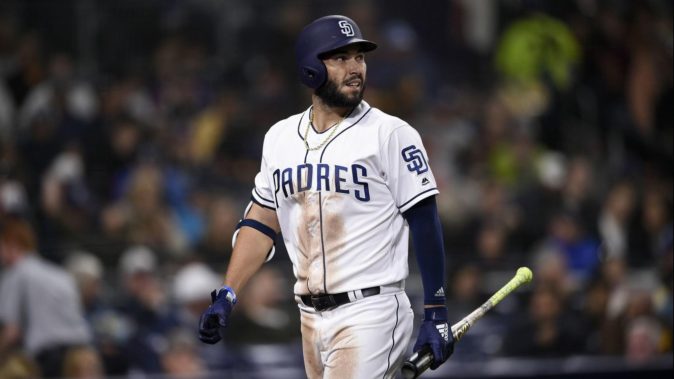
Credit: AP Photo
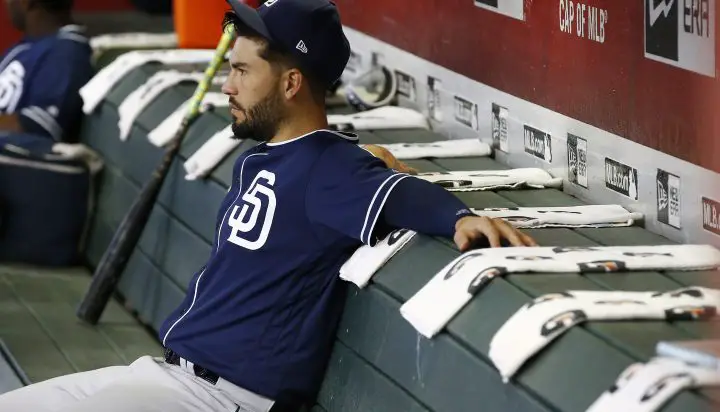
Is there any way to explain the disappointing season that Eric Hosmer had with the San Diego Padres in 2018? We delve into the issues Hosmer had in his first season with the Padres.
Far and away the most expensive current player on the Padres is Eric Hosmer, who has proven to be quite disappointing during his time with the team.
He’s due $21 million next season, which is three times more than the second-highest salary on the club.
Although he was signed in February of 2018 to be a cornerstone for the team, he promptly put up a mere -0.1 fWAR last season. He’s always been an inconsistent performer year-to-year, and last year was no exception. How could a player who put up 4.1 fWAR in value during the 2017 season, see his level of play drop off so quickly in the following season? Can he bounce back in 2019 as he usually does, following a down year in 2018?
To begin, we need to know what held him back last season as a hitter. Hosmer’s a first baseman, so the majority of his value is going to be derived from his bat. Here’s a table showing the differences in his offensive production between the 2017-18 seasons:
| Season | OBP | BB% | K% | wRC+ |
| 2017 | 0.385 | 9.8% | 15.5% | 135 |
| 2018 | 0.322 | 9.2% | 21.0% | 95 |
He failed to get on base as often, struck out more, and his offensive production declined overall significantly in 2018. Look at his gaudy 2017 numbers. In what other areas of his game did Hosmer change, outside of what the data above has told us? After all, his BABIP decreased from .351 in 2017 to .302 this past season. He clearly didn’t have the same luck on batted balls, which hindered his ability to produce offensively.
We should begin by talking about his launch angles on batted balls, to understand why his BABIP was so low. Here’s the Statcast data on Hosmer’s hitting in 2018:
| Season | Average Launch Angle | Average Exit Velocity | Barrels / PA % |
| 2017 | 3.8 degrees | 89.7 mph | 5.2% |
| 2018 | -1.2 degrees | 88.8 mph | 4.4% |
So Hosmer hit balls with a higher average launch angle in 2017 and unsurprisingly hit the ball harder with more consistency. This season, he started hitting the ball on the ground even more often, and his numbers suffered as a result. He lost almost a mile an hour on his average exit velocities, and his average launch angle ranked as the lowest among all qualified major league hitters. That’s never a good sign and is the principal reason as to why he didn’t live up to expectations with the bat last season.
Perhaps there’s something to be found in Hosmer’s hitting mechanics that may have changed from 2017-18. Here’s a swing from 2017 with the Royals on the left, and a later hack with the Padres in 2018 on the right:


Take a look at Hosmer’s leg kick on both swings, in particular. See how much higher his knee goes on the right than on the left? In real time it’s not very easy to see how his leg kicks are different in the two frames, so let’s freeze them at the height of his leg kick:
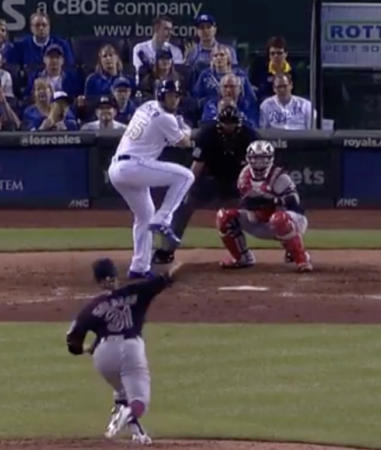
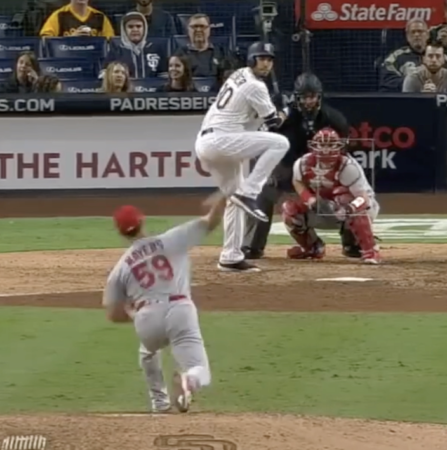
See how much closer Hosmer’s knee is to his elbow? Clearly, Hosmer had a much higher leg kick last season compared to the 2017 campaign. Maybe Hosmer was pressing in his first season with his new team, and that’s why his leg kick was higher. Also notable in his swing changes was his ability to get his foot down early before pitches arrived at the plate:
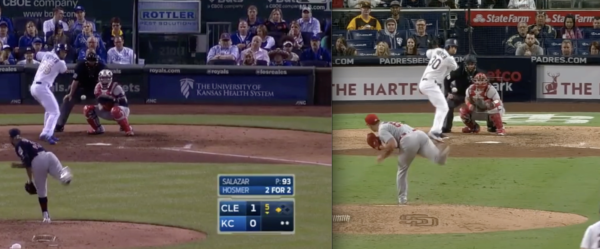
Hosmer’s front and back feet are aligned on the left, though are not in the frame on the right. He’s in a more balanced position in the frame on the left, which was key to his success in 2017. So clearly he should consider going back to his previous hitting mechanics, which could also help him bring up his average launch angle. This is a player who has shown himself to be a talented hitter at times during his tenure with the Royals, so the Padres should encourage him to go back to what worked for him there. Maybe he’ll never be a high launch angle guy, and it isn’t something that works for everyone.
Currently, the Padres just need the best version of Eric Hosmer they can get, and that doesn’t require him to try and hit home runs every at-bat. If he could simply increase his launch angle to five degrees, for example, it would likely work wonders for his hitting results. 2018 NL MVP Christian Yelich had an average launch angle of 4.7 degrees — as an example of a player who found considerable success with a more line-drive heavy approach. If Hosmer were to cut down on his strikeouts and hit more balls in the air, he’d be a much more valuable hitter for the Padres next season. In order to be the productive player he once was, Hosmer needs to make some relatively small adjustments to his hitting profile. After all, at least going back to the hitting mechanics he used in 2017 would allow Hosmer to drastically improve in 2019. The Padres will need him if they’re going to be competitive with this roster next season.
A sophomore at Willamette University in Oregon, Conrad is majoring in Spanish but is also a writing center assistant for other students at Willamette. He has been a Padres die-hard his whole life and hopes to bring comprehensible statistical analysis to the site.
Hosmer appears to be a “proud” person and therefore, he listens to heart and not his coaches. During his tough times in KC, bloggers pointed out his swing differences, so surely management knew that as well, but nothing changed. I was glad KC did not win the “sweepstakes??” for Eric Hosmer. KC might be a struggling losing team, but they would have been the same if Hosmer were still present. I hope that he finally listens and actually makes the necessary changes, he was extremely popular in KC. It would be sad if he were not to gain that popularity in his new home, just because he is inconsistent.
Very well done piece, but I’m wondering: did his offensive decline affect his demeanor in the clubhouse? If you recall, his leadership was one of the main reasons they signed him.
Now this is a good article. The differences between 2017 and 2018 swings are slight to the naked eye, maybe an inch or two in the height of the leg kick, but the results were night and day.
Two things really stand out about Hosmer. One, there is a lot of noise in his swing. Needless motion is something very few hitters can get away with. In general the better hitters have very quiet swings, with no wasted motion. Look how much his head moves, even in the 2017 swing. He’s bobbing up and down. This is a guy who has gotten away with a swing no player would ever be taught. Look at swings by Bonds, Ted Williams, or Mantle for comparison.
Two, these observations were not missed by the Royals. They tried for years to get him to change his approach, but he refused. He was regarded as uncoachable. This was masked slightly by KC not being so advanced sabermetrically (looking more at counting stats like HRs and RBIs), one of his down years coinciding with an injury (2014), and another being the year they won the WS (2016) when all sins are forgiven.
This is a player who has been a below average player in 5 of his 8 seasons. So, what to do? Clearly he is untradeable with his NTC, massive contract, and coming off such a stinker of a year. The only course of action is to get the player to change his swing. How to do what the Royals couldn’t? There are only two areas of leverage a club has, demoting or trading a player, or restricting his playing time. He can’t be traded or demoted, so that leaves his playing time.
Over the last 3 years here are his slash lines as against lefties and against righties: .229/.278/.363 and .304/.378/.483. He pounds right handed pitching and is owned by left handers. This certainly ties in with his excess swing motion and too low launch angle.
Solution: either he reworks his swing or he should be platooned. If it’s laid out to him calmly, like this article has done, there’s no reason he shouldn’t say “hmm, maybe you’re right” and work on quieting his swing.
Enjoyed your article Conrad. I wonder with Hosmer’s every other year good to not so good there is a pattern within the yo-yo results. From your writing to Hosmer’s eyes!
I agree, this was a great article. Your comment on Hosmer’s every other year, and Tanned Tom’s note about his “busy” swing mechanics might be added to Conrad’s swing analysis. What would that obtain? Maybe a player who falls into bad habits one year and corrects them the next?
2018 was a year of major adjustments for Hosmer, leaving the only franchise and home ballpark he’s known, playing road games in entirely new ballparks, and seeing pitchers he’s never seen before. He had to be pressing, especially after signing a big contract. As Conrad points out, there were unfortunate changes in his swing.
Hosmer has bounced back after poor even numbered years, so maybe we can expect another bounce in 2019. He WAS hitting rather well up to about mid-June, and started tailing off, curiously after Myers returned. I don’t want to read too much into that – it may be the bad habits crept in and NL pitchers made adjustments.
There are so many questions that need to be answered on this team, it should be no big deal that a Hosmer bounce-back is one of them.